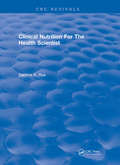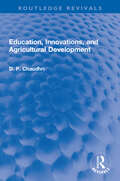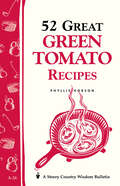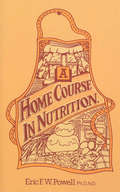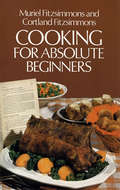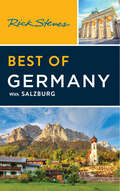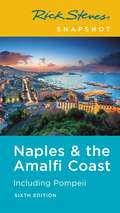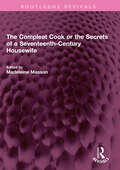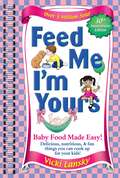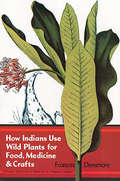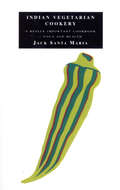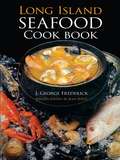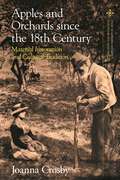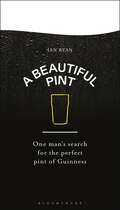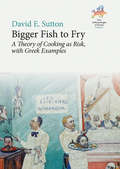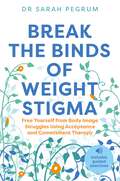- Table View
- List View
Clinical Nutrition For The Health Scientist (CRC Press Revivals)
by Daphne A. RoeNutrition manuals and textbooks are usually written to meet the needs of nutritionists or would-be nutritionists. This manual has been written to meet the needs of health professionals who are not nutritionists, including physicians, nurses and pharmacists. The aim is to acquaint readers in these professions with the principles of nutrition and the application of nutrition to the better delivery of health care.
Clinical Nutrition For The Health Scientist (CRC Press Revivals)
by Daphne A. RoeNutrition manuals and textbooks are usually written to meet the needs of nutritionists or would-be nutritionists. This manual has been written to meet the needs of health professionals who are not nutritionists, including physicians, nurses and pharmacists. The aim is to acquaint readers in these professions with the principles of nutrition and the application of nutrition to the better delivery of health care.
Education, Innovations, and Agricultural Development: A Study of North India (1961-72) (Routledge Revivals)
by D. P. ChaudhriFirst published in 1979, Education, Innovations, and Agricultural Development investigates the effect of education on agricultural productivity and innovations that took place in the wake of the Green Revolution in North India, using a simultaneous equations model. The Green Revolution of the 1960s, with its twin aims of raising production and improving the quality of input, was expected to induce a majority of farming families to respond to policies and programmes devised for bringing about development in agricultural sectors. Focusing on the wheat-growing areas of Punjab and Haryana, where high yielding varieties of seed have been introduced extensively, it shows that general education up to secondary level has a significant impact on the diffusion of technology and agricultural productivity and that higher production in turn increases the demand for education. This book deserves to be read by all concerned with development in Asian countries; agriculture; developmental economics; and educationists.
Education, Innovations, and Agricultural Development: A Study of North India (1961-72) (Routledge Revivals)
by D. P. ChaudhriFirst published in 1979, Education, Innovations, and Agricultural Development investigates the effect of education on agricultural productivity and innovations that took place in the wake of the Green Revolution in North India, using a simultaneous equations model. The Green Revolution of the 1960s, with its twin aims of raising production and improving the quality of input, was expected to induce a majority of farming families to respond to policies and programmes devised for bringing about development in agricultural sectors. Focusing on the wheat-growing areas of Punjab and Haryana, where high yielding varieties of seed have been introduced extensively, it shows that general education up to secondary level has a significant impact on the diffusion of technology and agricultural productivity and that higher production in turn increases the demand for education. This book deserves to be read by all concerned with development in Asian countries; agriculture; developmental economics; and educationists.
52 Great Green Tomato Recipes: Storey's Country Wisdom Bulletin A-24 (Storey Country Wisdom Bulletin)
by Phyllis HobsonThe first frost doesn&’t have to be the end of your tomatoes! Preserving expert Phyllis Hobson offers dozens of delicious recipes for preserving and cooking with green tomatoes. You&’ll find everything from green tomato preserves and pickles to mincemeat, croquettes, omelets, sweet and savory pies, casseroles, salads and salad dressings, a cake with green tomato filling, classic fried green tomatoes, and more. Hobson also shows you how to ripen your green tomatoes indoors so that you can enjoy fresh ripe tomatoes well into the fall and even early winter.
A Home Course In Nutrition
by Eric F PowellThis book provides lessons in nutrition which are intended as a helpful and practical guide to proper feeding, and cover the whole of the necessary matters connected with the subject. Food on the mind has not been neglected.Readers who carry out the suggestions made to the best of their ability will add greatly to life and happiness. Read and apply, and results are assured.
Fortschritte in der parenteralen Ernährung (Klinische Anästhesiologie und Intensivtherapie #13)
by F. W. Ahnefeld E. Rügheimer H. Bergmann C. Burri W. Dick M. Halmagyi L. HellerCooking for Absolute Beginners
by Muriel Cortland Fitzsimmons FitzsimmonsWhich is the best cookbook for a beginner? Over the years, many beginning cooks have found this cookbook to be their favorite. It assumes no previous cooking knowledge at all, and it takes absolutely nothing for granted. Complete, well-organized, and extremely thorough, this cookbook progresses slowly and clearly so that you know exactly what to do every step of the way.Even before the first recipe appears, there are pages of important information you need to know: a long list of definitions, tables of measurements and equivalents, and commentary on stoves and kitchen tools. The simplest meal is breakfast, so the first recipes are for preparing fresh and stewed fruits, breakfast cereals, coffee and tea, eggs, breakfast meats, and toast. Then the author tells you how to have a complete meal ready on time and all about seasonings.The meat of the book is next: chapters on buying and cooking meats, fish and seafood, poultry and game, vegetables from artichokes to turnips, and how to make basic sauces, soups, cereal products, casseroles, salads and salad dressings, breads and biscuits, desserts (pies, cookies, cake, and more), and some jams and jellies.Most cooks only learn the basics of cooking when it's absolutely necessary -- after a recipe fails because the cook was unclear about what to do. This book teaches you the essentials of cooking at the beginning and gets you started in the right direction. Beginners will find it invaluable, and experienced cooks will learn a few things from it as well -- things they should have learned when they were beginners.
Rick Steves Best of Germany: With Salzburg (Rick Steves Travel Guide)
by Rick StevesHit Germany's can't-miss art, sights, and bites in two weeks or less with Rick Steves Best of Germany! Inside you'll find:Strategic advice from Rick Steves on what's worth your time and money Short itineraries covering Munich, Bavaria, Rothenburg and the Romantic Road, the Rhine Valley, and Berlin, plus Salzburg, Austria Rick's tips for beating the crowds, skipping lines, and avoiding tourist traps The best of local culture, flavors, and haunts, including walks through museums and atmospheric neighborhoods Trip-planning strategies like how to link destinations and design your itinerary, what to pack, where to stay, and how to get around Over 400 full-color pages with maps and vibrant photosSuggestions for side trips to Dachau Memorial, Würzburg, Nürnburg, Burg Eltz, Cologne, Baden-Baden, Frankfurt, Dresden, and Hamburg Experience the old-world romance and modern-day excitement of Germany with Rick Steves. Planning a longer trip? Pick up Rick Steves Germany, the classic, in-depth guide to spending two weeks or more exploring the country.
Rick Steves Snapshot Naples & the Amalfi Coast: Including Pompeii (Rick Steves Travel Guide)
by Rick StevesWith Rick Steves, Naples and the Amalfi Coast are yours to discover! This slim guide excerpted from Rick Steves Italy includes:Rick's firsthand, up-to-date advice on the Amalfi Coast's best sights, restaurants, hotels, and more, plus tips to beat the crowds, skip the lines, and avoid tourist trapsTop sights and local experiences: See ancient art at Naples' Archaeological Museum or travel back in time at the Pompeii Forum. Relax on the beach in Positano, go for a cliffside stroll along the coast, or feast on pizza where the dish was first createdHelpful maps and self-guided walking tours to keep you on trackWith selective coverage and Rick's trusted insight into the best things to do and see, Rick Steves Snapshot Naples & the Amalfi Coast is truly a tour guide in your pocket.Exploring beyond the Amalfi Coast? Pick up Rick Steves Italy for comprehensive coverage, detailed itineraries, and essential information for planning a countrywide trip.
The Compleat Cook or the Secrets of a Seventeenth-Century Housewife (Routledge Revivals)
by Rebecca PriceFirst published in 1974, The Compleat Cook is a book to inspire any creative cook in the days of tasteless, mass-produced foods. By the subtle use of herbs, wines and flavorings of all kinds Rebecca Price has provided us with multitude of new culinary experiences. These are the recipes of a practical cook, collected, tried and commented upon with meticulous care. Furthermore the book also tells us about Rebecca, her family, friends, servants, her kitchen and even the silver she used as hostess to many guests throughout her life in Westbury, Bucks, in London and in Houghton Regis, Beds. Madeleine Masson in her introduction is able to set Rebecca Price’s work in a scholarly historical context to give a lively account of her family background. This book will be a useful resource for collectors of cookery books and also for social historians and students of food history.
The Compleat Cook or the Secrets of a Seventeenth-Century Housewife (Routledge Revivals)
by Rebecca PriceFirst published in 1974, The Compleat Cook is a book to inspire any creative cook in the days of tasteless, mass-produced foods. By the subtle use of herbs, wines and flavorings of all kinds Rebecca Price has provided us with multitude of new culinary experiences. These are the recipes of a practical cook, collected, tried and commented upon with meticulous care. Furthermore the book also tells us about Rebecca, her family, friends, servants, her kitchen and even the silver she used as hostess to many guests throughout her life in Westbury, Bucks, in London and in Houghton Regis, Beds. Madeleine Masson in her introduction is able to set Rebecca Price’s work in a scholarly historical context to give a lively account of her family background. This book will be a useful resource for collectors of cookery books and also for social historians and students of food history.
Feed Me I'M Yours: Baby Food Made Easy
by Vicki LanskyAmerica's classic cookbook for parents of young children The 30th anniversary edition of this classic cookbook for parents of tots and toddlers contains some of the most popular recipes for baby food, finger food, snacks and desserts ever published. Fully updated, this new edition includes information on the newest Food Pyramid Guide, sample servings for young children, organic baby food options, when to introduce new solids and which to try first, vegetarian baby food options, handling and storing baby food, safe uses of microwaves, the latest equipment for making baby food at home, foods likely to cause allergies and how long to delay introduction of these foods. More than just a cookbook, Feed Me I'm Yours provides time-saving, trouble-saving, and money-saving tips. It also contains entertaining "edible craft" activities for celebrating birthdays, the seasons and major holidays.
How Indians Use Wild Plants for Food, Medicine & Crafts
by Frances Densmore"Learn the natural ways of the Chippewa Indians with this great book from Dover." — Texas Kitchen and Garden and MoreThe uses of plants — for food, for medicine, for arts, crafts, and dyeing — among the Chippewa Indians of Minnesota and Wisconsin show the great extent to which they understood and utilized natural resources. In this book those traditions are captured, providing a wealth of new material for those interested in natural food, natural cures, and native crafts.In separate sections describing the major areas of use, Miss Densmore, an ethnologist with the Smithsonian Institution, details the uses of nearly 200 plants with emphasis on wild plants and lesser-known uses. For those interested in natural foods she gives extensive coverage to the gathering and preparation of maple sugar and wild rice, as well as preparations for beverages from leaves and twigs of common plants, seasonings including mint and bearberry, the methods of preparing wild rice and corn, cultivated and wild vegetables, and wild fruits and berries. On Indian medicines she tells the basic methods of gathering plants and the basic surgical and medical methods. Then she gives a complete list of the plants with their botanical names, uses, parts used, preparation and administration, and other notes and references. Also covered are plants used as charms, plants used in natural dyes, and plants in the useful and decorative arts including uses for household items, toys, mats, twine, baskets, bows, and tools, with special emphasis on the uses of birch bark and cedar. This section will be especially useful for supplying new and unusual craft ideas. In addition, 36 plates show the many stages of plant gathering and preparation and many of the artistic uses. While a number of the plants discussed are native only to the Great Lakes region, many are found throughout a wide range.Those studying the Indians of the Great Lakes region, or those trying to get back to nature through understanding and using natural materials, will find much about the use of plants in all areas of community life. Because of Miss Densmore’s deep knowledge and clear presentation, her study remains a rich and useful source for learning about or using native foods, native cures, and native crafts.
Indian Vegetarian Cookery
by Jack Santa MariaThis book contains appetising recipes collected from all over India. They reflect a traditional view in which each daily act - including preparation, cooking and eating - forms a part of the divine gift of life.The creative use of foods and spices, and the variety of vegetable cooking techniques, allow the enthusiast to choose a delightful and well balanced menu for every day of the year.
Long Island Seafood Cookbook
by Jean Joyce J. George FrederickNoted gourmet and seafood authority presents more than 400 recipes covering chowders (mussel chowder, oyster chowder, etc.), clams (stuffed clams, soft shell clams Newburg, etc.), flounder (cebiche, cider flounder, etc.), crab (crab curry, crab soup, baked crab, etc.). ... and many more, including bouillabaisse, fish pies, and numerous tasty sauces.
Rick Steves Best of Germany: With Salzburg (Rick Steves Travel Guide)
by Rick StevesHit Germany's can't-miss art, sights, and bites in two weeks or less with Rick Steves Best of Germany! Inside you'll find:Strategic advice from Rick Steves on what's worth your time and moneyShort itineraries covering Munich, Bavaria, Rothenburg and the Romantic Road, the Rhine Valley, and Berlin, plus Salzburg, AustriaRick's tips for beating the crowds, skipping lines, and avoiding tourist trapsThe best of local culture, flavors, and haunts, including walks through museums and atmospheric neighborhoodsTrip-planning strategies like how to link destinations and design your itinerary, what to pack, where to stay, and how to get aroundOver 400 full-color pages with maps and vibrant photosSuggestions for side trips to Dachau Memorial, Würzburg, Nürnburg, Burg Eltz, Cologne, Baden-Baden, Frankfurt, Dresden, and HamburgExperience the old-world romance and modern-day excitement of Germany with Rick Steves.Planning a longer trip? Pick up Rick Steves Germany, the classic, in-depth guide to exploring the country.
Apples and Orchards since the Eighteenth Century: Material Innovation and Cultural Tradition (Food in Modern History: Traditions and Innovations)
by Joanna CrosbyShowing how the history of the apple goes far beyond the orchard and into the social, cultural and technological developments of Britain and the USA, this book takes an interdisciplinary approach to reveal the importance of the apple as a symbol of both tradition and innovation. From the 18th century in Britain, technology innovation in fruit production and orchard management resulted in new varieties of apples being cultivated and consumed, while the orchard became a representation of stability. In America orchards were contested spaces, as planting seedling apple trees allowed settlers to lay a claim to land. In this book Joanna Crosby explores how apples and orchards have reflected the social, economic and cultural landscape of their times. From the association between English apples and 'English' virtues of plain speaking, hard work and resultant high-quality produce, to practices of wassailing highlighting the effects of urbanisation and the decline of country ways and customs, Apples and Orchards from the Eighteenth Century shows how this everyday fruit provides rich insights into a time of significant social change.
A Beautiful Pint: One Man's Search for the Perfect Pint of Guinness
by Ian RyanWhat makes a perfect pint of Guinness? What are the criteria for a great pub? And where can you find them? Ian Ryan, founder of Sh*t London Guinness and Beautiful Pints, can answer these questions and help you find a beautiful pint, wherever you are.We've all got a friend who claims to know where you can get the best pint of Guinness. From the pub to the pour, it's an experience. And if anyone knows this best, it's London-based Corkman Ian Ryan – founder of Sh*t London Guinness and Beautiful Pints.From the all-important different elements of a Guinness pour to what to look for (and what to run a mile from) when sourcing beautiful pints, as well as a crème de la crème list of pubs around the world to visit, Ian shares his expertise from many a pint of plain sank and enjoyed. By the end of it, you'll be able to claim that you know where to get the ultimate pint of Guinness in town. See you at the bar sometime.
Bell pepper (Cross-section) (Large Print)
This is a labelled image of a bell pepper in longitudinal cross section (cut through from top to bottom). There is a locator dot shown, which will be at the top left of the page when the image is the correct way up. The image of the bell pepper is in the middle of the page. At its centre is the fruits core covered by seeds. Around the core is a void, and around this, on the outside of the fruit, are its flesh and skin. At the top of the image is the peppers stem. The pepper is about ten centimetres long and although bright green when immature, can be be red, yellow or even orange when fully ripened.
Bell pepper (Cross-section) (UEB Contracted)
This is a labelled image of a bell pepper in longitudinal cross section (cut through from top to bottom). There is a locator dot shown, which will be at the top left of the page when the image is the correct way up. The image of the bell pepper is in the middle of the page. At its centre is the fruits core covered by seeds. Around the core is a void, and around this, on the outside of the fruit, are its flesh and skin. At the top of the image is the peppers stem. The pepper is about ten centimetres long and although bright green when immature, can be be red, yellow or even orange when fully ripened.
Bell pepper (Cross-section) (UEB Uncontracted)
This is a labelled image of a bell pepper in longitudinal cross section (cut through from top to bottom). There is a locator dot shown, which will be at the top left of the page when the image is the correct way up. The image of the bell pepper is in the middle of the page. At its centre is the fruits core covered by seeds. Around the core is a void, and around this, on the outside of the fruit, are its flesh and skin. At the top of the image is the peppers stem. The pepper is about ten centimetres long and although bright green when immature, can be be red, yellow or even orange when fully ripened.
Bigger Fish to Fry: A Theory of Cooking as Risk, with Greek Examples (New Anthropologies of Europe: Perspectives and Provocations #3)
by David E. SuttonWhat defines cooking as cooking, and why does cooking matter to the understanding of society, cultural change and everyday life? This book explores these questions by proposing a new theory of the meaning of cooking as a willingness to put oneself and one’s meals at risk on a daily basis. Richly illustrated with examples from the author’s anthropology fieldwork in Greece, Bigger Fish to Fry proposes a new approach to the meaning of cooking and how the study of cooking can reshape our understanding of social processes more generally.
Break the Binds of Weight Stigma: Free Yourself from Body Image Struggles Using Acceptance and Commitment Therapy
by Dr Sarah Pegrum"I can't do that until I've lost a bit of weight". "I need to slim down first". "When I'm thinner I'll..."What if you didn't feel held back by your body? This guide helps you to free yourself from harmful social attitudes about weight and to start living now.Break the Binds of Weight Stigma draws on Acceptance and Commitment Therapy (ACT), a positive, action-based form of therapy that works by accepting your natural emotions and using your own personal values to build a path to the life you want to live. Stories, worksheets, reflection questions, and guided exercises show you how to embrace yourself and fight back against the social structures that tie value to size. This is not a book about changing your body or losing weight. It's a guide to help you connect with the things that are important to you regardless of your weight. It's a step towards countering the harmful messages in society about our bodies. It's a movement. It's radical. It's freedom.
